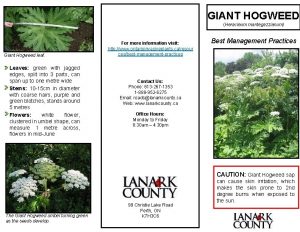GIANT HOGWEED Heracleum mantegazzianum Giant Hogweed leaf Leaves


- Slides: 2

GIANT HOGWEED (Heracleum mantegazzianum) Giant Hogweed leaf. Leaves: green with jagged edges, split into 3 parts, can span up to one metre wide Stems: 10 -15 cm in diameter with coarse hairs, purple and green blotches, stands around 5 metres Flowers: white flower, clustered in umbel shape, can measure 1 metre across, flowers in mid-June For more information visit: http: //www. ontarioinvasiveplants. ca/resour ces/best-management-practices Best Management Practices Contact Us: Phone: 613 -267 -1353 1 -888 -952 -6275 Email: roads@lanarkcounty. ca Web: www. lanarkcounty. ca Office Hours: Monday to Friday 8: 30 am – 4: 30 pm CAUTION: Giant Hogweed sap The Giant Hogweed umbel turning green as the seeds develop. 99 Christie Lake Road Perth, ON K 7 H 3 C 6 can cause skin irritation, which makes the skin prone to 2 nd degree burns when exposed to the sun.

Giant Hogweed is a tall, monocarpic perennial (flowers once before dying) which spreads by seed. Giant Hogweed grows in locations that are undisturbed with lots of light, as well as on forest edges with little shade. Regardless of the management option, always wear protective clothing and eye protection when controlling Wild Parsnip Mow Infested areas should be mowed as soon as the umbel starts to flower, but BEFORE seeds set to prevent seed production. Mowing after seed production can increase Giant Hogweed populations. Dig For SMALL infestations, remove Giant Hogweed plants using a shovel. The best times for removal are after rain when the ground is soft, or during times of drought (when the taproot shrinks). Tarp Cover the ground with a tarp to smother new growth following other control methods like mowing or digging. Leave tarp for at least one full growing season and replant following tarping to rehabilitate the area. Target the Giant Hogweed plants with a glyphosate herbicide in the spring. Treating Spray Giant Hogweed in full flower may not prevent seed production. Till In agricultural areas, seasonal tilling of the soil will prevent Giant Hogweed from infesting agricultural fields. DISPOSAL After removal, DO NOT burn. Leave the stems at the removal site to completely dry out for at least one week. Giant Hogweed infestation sectioned off. IMPACTS Note: If seeded, DO NOT compost. Place the weeds in a black garbage bag and dispose with household garbage. Giant Hogweed infestation. Giant Hogweed outcompetes and shades out native plants RESTORATION After control, replant the area with native plant species to prevent re-infestation. Health risk for people and animals MONITORING Reduced forage crop quality Giant Hogweed seeds. Monitoring should be repeated throughout the growing season to ensure plants are not re-sprouting.



